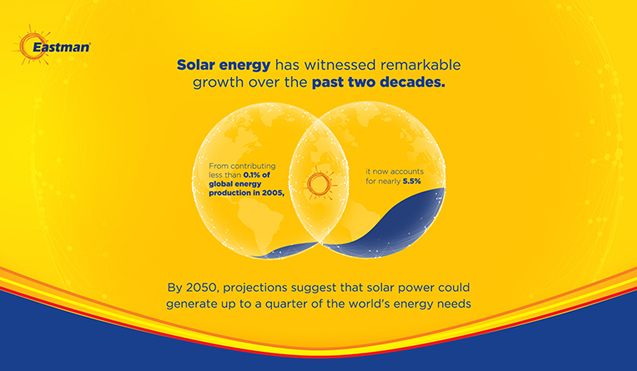The 3S Mantra for Powering the Future

As the world grapples with the urgent challenge of climate change, a transformative shift toward renewable energy is underway. Among these sources, solar power stands out as a cornerstone of this transition. However, to fully unlock its potential, three critical elements—sustainability, storage, and stability—must be addressed. While sustainability underscores the environmental promise of solar energy, storage and stability are pivotal in ensuring its reliability and integration into modern energy systems.
Sustainability: The Foundation of Solar Energy
Solar energy has witnessed remarkable growth over the past two decades. From contributing less than 0.1% of global energy production in 2005, it now accounts for nearly 5.5%. By 2050, projections suggest that solar power could generate up to a quarter of the world's energy needs. This rapid expansion highlights its growing importance in the global energy mix.
Unlike traditional fossil fuels, solar energy is inherently sustainable, producing no harmful emissions during operation. Its environmental footprint is minimal, making it an ideal solution for combating climate change. However, despite its advantages, solar energy faces unique challenges. Its intermittent nature means energy generation is limited to daylight hours, with output varying due to weather conditions such as cloud cover. Additionally, peak energy demand often occurs during the late afternoon and evening, when solar generation tends to decline. Addressing these challenges requires innovative storage solutions capable of bridging the gap between energy generation and consumption.
Storage: Unlocking the Potential of Solar Power
Energy storage technologies play a crucial role in overcoming the intermittency of solar power. They enable excess energy generated during periods of high sunlight to be stored and utilized when production is low. Several advanced storage solutions are emerging as key enablers of solar energy adoption.
Lithium-ion batteries are among the most widely used storage technologies. Their high Depth of Discharge (DOD) allows a significant portion of their capacity to be utilized before recharging, making them efficient and reliable. Compact in size, long-lasting, and capable of holding energy for extended durations, lithium-ion batteries are integral to residential and grid-scale solar applications.
Hydrogen storage offers another promising avenue. Through electrolysis, electricity from solar panels splits water into hydrogen and oxygen. The hydrogen gas is then stored under pressure and later converted back into electricity using fuel cells. This method boasts high energy density and is environmentally friendly, positioning hydrogen as a viable long-term storage solution.
Thermal energy storage is yet another approach, where heat is captured in materials like water or molten salt and stored in insulated tanks. This stored thermal energy can be used directly for heating and cooling or converted into electricity by driving turbines with steam. Similarly, pumped-storage hydropower leverages solar energy to pump water uphill into reservoirs during periods of low demand. When energy is needed, the water flows downhill, spinning turbines to generate electricity. As the most widely adopted storage technology globally, pumped-storage hydropower demonstrates the scalability of storage solutions.
These innovations collectively address the intermittency of solar energy, ensuring a consistent and balanced supply of electricity. In doing so, they contribute to the stability of the electrical grid—a critical factor in the widespread adoption of solar power.
Stability: The Backbone of Renewable Integration
Grid stability is essential for integrating solar power into modern energy systems. Unlike conventional power plants, which can be adjusted to match demand, solar energy production fluctuates based on weather conditions and time of day. Sudden changes, such as cloud cover, can lead to rapid drops in output, while bright days may result in surplus energy generation. To maintain efficiency, a grid's frequency must remain within a narrow range of 50Hz to 60Hz. Deviations from this range can compromise safety and reliability.
Sophisticated grid management techniques, supported by robust storage solutions, are necessary to mitigate these fluctuations. Storage systems help smooth out variations in supply and demand, ensuring a stable and reliable energy grid.
Global Approaches to Grid Stability
Countries around the world are employing diverse strategies to tackle the challenges of grid stability, leveraging storage technologies alongside innovative policies and infrastructure upgrades.
India is investing in large-scale storage systems, including pumped hydro storage and Battery Energy Storage Systems (BESS), to enhance grid resilience. China leads the world in grid-scale battery storage installations, adding nearly 5 GW annually. The United States follows closely, with approximately 4 GW of annual additions. To further accelerate deployment, the U.S. introduced the Inflation Reduction Act in 2022, offering investment tax credits for standalone storage projects.
In Europe, Germany is developing high-voltage direct current lines to distribute wind power from the North to the South and excess solar power in the opposite direction. Sweden is upgrading its grid infrastructure, promoting distributed solar power paired with home energy storage systems, and employing demand response mechanisms to manage fluctuations in supply and demand.
While each country tailors its approach to local conditions, storage solutions remain central to addressing grid stability challenges. By 2030, solar power is expected to account for more than half of new power generation capacity, underscoring the critical role of storage in ensuring reliable and sustainable energy systems.
A Vision for the Future
At Eastman Auto and Power, we are deeply inspired by the transformative potential of storage solutions in harnessing solar energy. These technologies pave the way for a future where energy is not only clean but also abundant and accessible. At Eastman Auto and Power, we are committed to realizing this vision by addressing pressing challenges such as intermittency and grid stability. Our mission is to empower homes and businesses with reliable, sustainable electricity, fostering a world where renewable energy drives progress and prosperity.
The journey toward a sustainable energy future is well underway, and the 3S mantra—sustainability, storage, and stability—serves as our guiding framework. Together, we can build a cleaner, greener world powered by the limitless potential of solar energy.